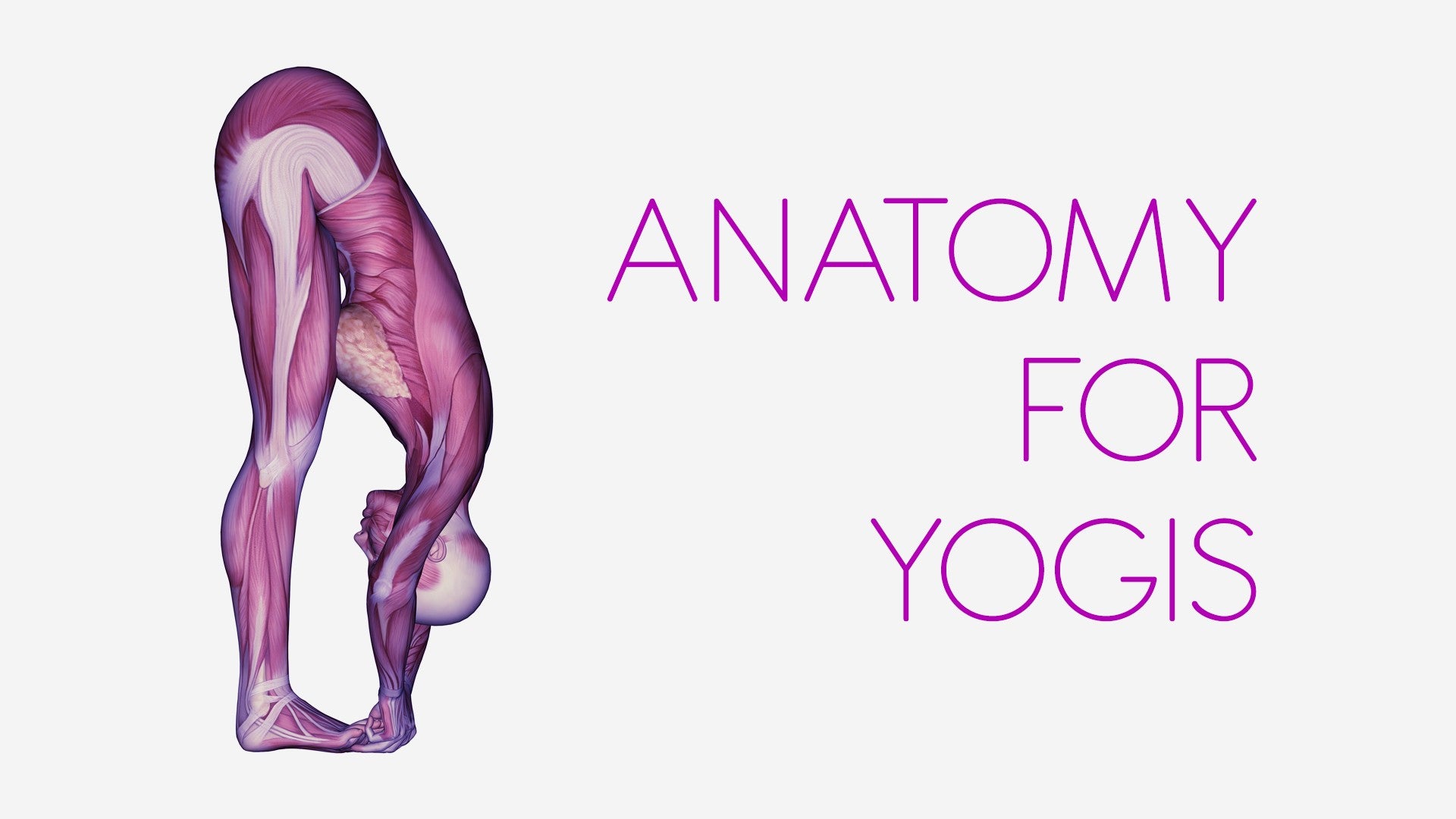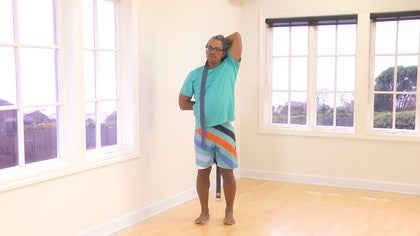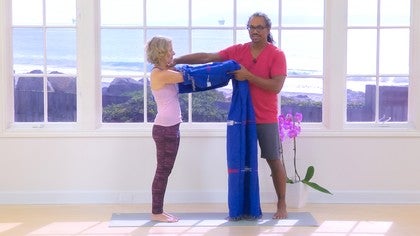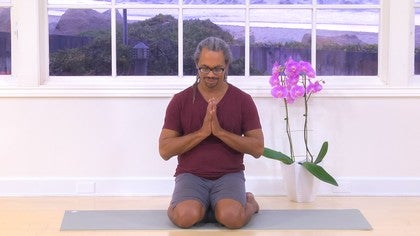Description
About This Video
Transcript
Read Full Transcript
Hi, welcome back. It's Arturo and I'm here with my friend Tina. We're gonna spend a little bit of time talking about connective tissue and just a brief intro to connective tissue. It's often a term often used in yoga classes especially in in yoga classes and just what exactly is connective tissue. Connective tissue in the body is pretty much absolutely everywhere. If we didn't have connective tissue wrapping our organs, wrapping our nerves and muscles together, we would basically need a bucket and then we would need in order to move around we would need to have a friend who had connective tissue in order to lift that bucket and move us around. Connective tissue gives us our form and structure and the different types of connective tissue in the body. The one that we often talk about is fascia or fibrous connective tissue but also cartilage is a form of connective tissue, bone is a form of connective tissue, blood is even a form of connective tissue which was a really confusing one to me at first and also adipose tissue is a form of connective tissue. One thing that's in common with all of these different types of connective tissue is that all forms of connective tissue are changeable or plastic. They can change shape and form depending on the stresses put on the connective tissue. One common form of influence put on connective tissue in yoga classes is to use heat to turn up the heat because heat makes the connective tissue especially the fascia the fibrous connective tissue it makes it more liquidy. Hormones also change connective tissue when you get pregnant there's a connective tissue hormone released called relaxin that softens the connective tissue allowing for the connective tissue to stretch for the baby to grow and also allowing for the pelvis to separate and open so the head can get out of the of the birth canal. With fascia and connective tissue one of the big ways to help lengthen the fascia is to use a low intensity meaning a low load stretch and you hold it for a long duration. Time is a big factor in lengthening the fascia in the body that's why in practices like in yoga you often are holding the pose for at least two minutes if not three minutes up to five up to 20 minutes in some of the poses and that time and the lengthened position allows the connective tissue to gradually gradually lengthen. So we're gonna just look at a model and we're going to use our imaginations to get a little more understanding of how connective tissue works within a muscle. So Tina can you face this way using our imagination I'm going to take a sheet of connective tissue Tina's arm is going to be a muscle fiber so this is the part of the muscle that does the work of contracting and this muscle fiber is to be wrapped in connective tissue but one muscle fiber is not enough to make a muscle so we need another muscle fiber bravo and that connective tissue is also wrapped or that fiber is also wrapped in connective tissue. Two fibers doesn't make a muscle so we have another fiber that we bundled together in connective tissue so we have a bundle of muscle fibers then we're gonna zoom our view out using our imagination and look at that bundle of muscle fibers that's wrapped in connective tissue and let's add another bundle of fibers and wrap that in connective tissue and then get another bundle of fibers and wrap the bundle in connective tissue and then bundled the bundles in connective tissue and we're going to repeat that several times bundling the bundles of bundled fibers in connective tissue every time until we get to what is a recognizable muscle. Now the part of the muscle that does the work, the muscle fiber ends right here. I can feel her hands ending right here, but the connective tissue continues on. This is the tendon. So the tendon isn't just starting right here, but it's a continuation of the connective tissue through the full length of the muscle, blending into the bone at this end and also blending into the bone at this end. If you can imagine I'm the bone and this connective tissue is going to blend into the connective tissue that covers the bone. And this is continuous substance. All of this connective tissue is continuous through the bone, through the length of the muscle, to the next bone, wrapping the next bone. And that's one of the more fascinating things about connective tissue, that the connective tissue systems of the entire body are continuous. It's a continuous substance. We have the same pattern in nerve fiber, so now Tina is no longer a muscle fiber, she's a nerve fiber. And actually her body is the spinal cord. So the spinal cord and the brain are wrapped in three very famous layers of connective tissue called the meninges. And at each spinal level we have nerves coming off. And the nerves are wrapped in, that's right, you got it, connective tissue. One nerve is not enough to make a spinal nerve, so we have another nerve fiber wrapped in connective tissue. Are you noticing a familiar pattern here? And another nerve wrapped in connective tissue, zoom out, bundle the nerves upon nerves in connective tissue until we get to a visible, recognizable nerve. When this nerve comes out it's going to come down to, say, the little toe. So this nerve is going to go into, let's say, right into a shoulder muscle. As the nerve goes into the shoulder muscle to create movement or to bring sensation back towards the brain and spinal cord, the connective tissue is going to blend into the connective tissue covering of the muscle. And this, again, is continuous, a continuous substance. The connective tissue that's blending into the arm or the little toe is covering the nerve, continuous with the connective tissue that wraps the brain and spinal cord, continuous with the connective tissue that separates the two sides of the brain. It is a continuous substance. One of the teachers at Lulu Bandhas in Ojai, when I was teaching this, she mentioned that it sounds like connective tissue is the body's expression of unity. And I said, oh yes, exactly, I'm gonna borrow that. Another thing to remember about connective tissue is all forms of connective tissue are changeable. They will all change and react to change form depending on what stresses are put on the connective tissue. That goes from fascia, the connective tissue that wraps the nerves and wraps the body, all the way into the bone. Bone will change shape depending on what position you're holding the body in and what kind of stresses you put on the body. On our next segment, we're going to look at how the connective tissue of the body is affected by sitting, by the amount of sitting that we're doing, especially when we're doing laptop asana or smartphone asana and how that affects the connective tissue in the body. For this next part, we're gonna bring in a chair. So when we look at laptop asana, most often what you see in people who are working on a laptop is they have the keyboard on a table or on their lap and they might start off with really beautiful posture, sitting up tall, keeping their neck long. But with the laptop, the screen is quite low and what most often happens as you're sitting at the laptop, getting very concentrated into your work, is that the back starts to round, the upper back starts to round and because you want to get your eyes closer to the screen, you end up in this very kind of crunched position. With the upper back rounding quite a bit, a lot of times the lower back is rounding and then the top of the neck getting a little jammed as the chin comes forward. Why is this a problem? Because we're sitting at the computer for hours and hours and hours and as we sit at the computer, the connective tissue starts to change to this shape. The connective tissue, talking about the fascia at the base of the skull, starts to shorten and compress. The connective tissue through the mid back lengthens and the connective tissue across the chest shortens. So in the short term, that's okay, but as you stay here for enough hours, that fascia is gonna hold that position so that when you stand up, the chest is still claps forward, the chin is jetting forward with the upper occipital is compressed and that becomes your new, that becomes the new normal. If you stay in this position long enough, the connective tissue of the bones, the bones can even start to change shape. The vertebrae can start to wedge in different, in the different directions that you're stuck in so that eventually as you stay in this long enough, even your bones are gonna mold to this position and when your bones mold to this position, it takes quite a bit longer to create change. It'll take a lot of years for your bones to get into that position and then then you're gonna be pretty stuck there and it can be a new lifetime of a hobby to undo that posture. So better to catch it while you're younger. One of the things that you can do here, one of the things I recommend for people with laptop asana is to buy an external keyboard and what we do with the external keyboard is remove the actual laptop from the lap and put it up higher. Oh look what happens and then we have the external keyboard down at her lap height so she can keep length in the spine, length in the back of the neck, the heart opening and the keyboard at a comfortable position for her for her arms and shoulders. Sometimes people try to lift the laptop and then use the keys up here maybe like that and what often happens with this pose is that the shoulders start to migrate into the ears. Yeah that's very common and and if that is held long enough that connective tissue is going to shorten and so that when she's not on the laptop her body is still holding the laptop. It brings me a lot of work as a massage therapist. Laptops, same thing with the smartphone, brings a lot of work as a massage therapist and you can avoid a lot of that by paying attention to your posture, being mindful while you're working and avoiding the laptop asana.
Anatomy for Yogis: Arturo Peal
Comments
You need to be a subscriber to post a comment.
Please Log In or Create an Account to start your free trial.












